New partnership announced with Borderless
Sona and Borderless announce an exciting partnership.
Building a staff schedule couldn’t be easier.
Reduce payroll errors with real-time T&A.
Fill 50% more shifts with your own employees.
Ensure shifts are covered even if you're understaffed.
Manage absence requests and approvals.
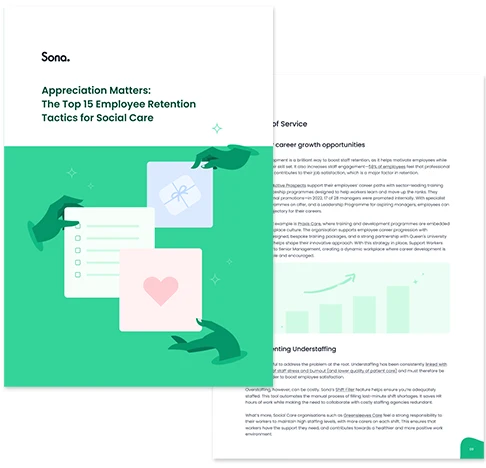
Practical ways to boost team morale with proven examples from across the sector.
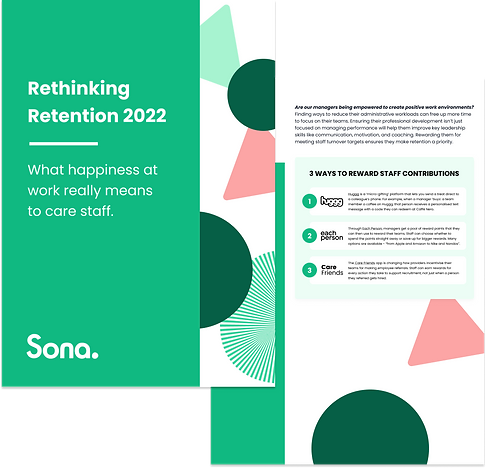
Find out what care employees say matters to them most at work.
Search and view employees with customised permission levels.
Key employment information all in one place.
Store visas, professional certifications and more with easy access.
Control personal and operational details of your staff.
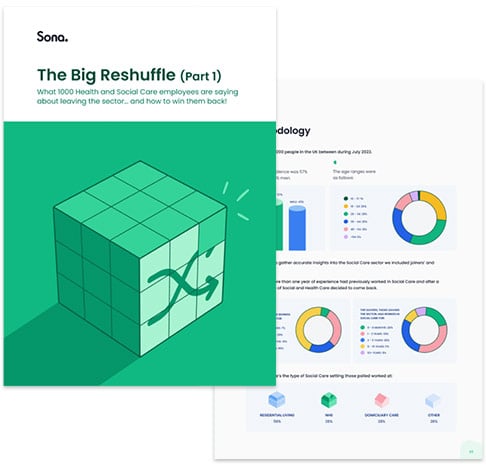
Why are people leaving Social Care, and where are they going?
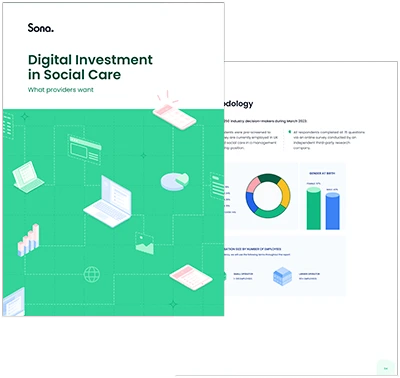
We asked 250 Social Care leaders about their attitudes towards digitisation and their plans for the next 12 months...
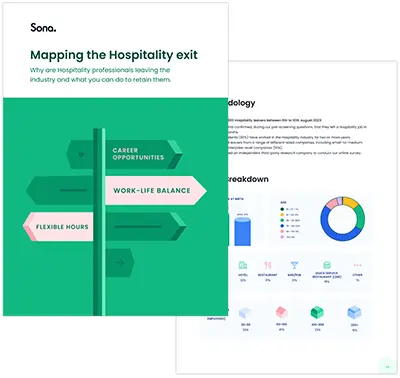
Why are Hospitality workers leaving the industry, and what can you do to retain them?
Share updates with a single click.

Staff can see relevant messages in one place.
Request post-shift feedback from staff.
Recognise staff contributions by sending them praise.
Identify staff at risk of churning.
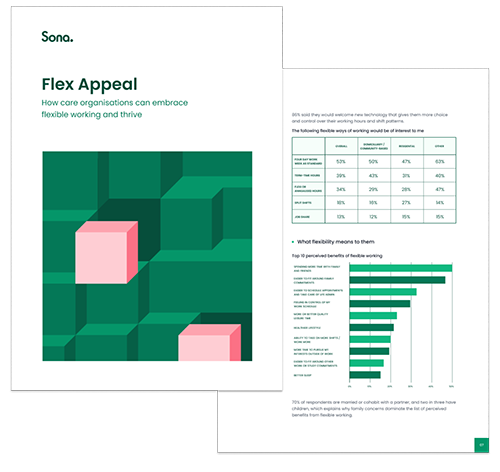
How care organisations can embrace flexible working and thrive.
Maintain quality of care and reduce costs.
Maximise profitability through AI-powered forecasting & scheduling.
Elevate your operational efficiency and guest satisfaction.
Streamline operations across sites.
Developed alongside Social Care experts with decades of combined experience.
See why we are the leading user-friendly, end-to-end platform that prioritises both efficiency and wellbeing.
The Sona Partner Network is an ecosystem of solution experts and complementary technologies.
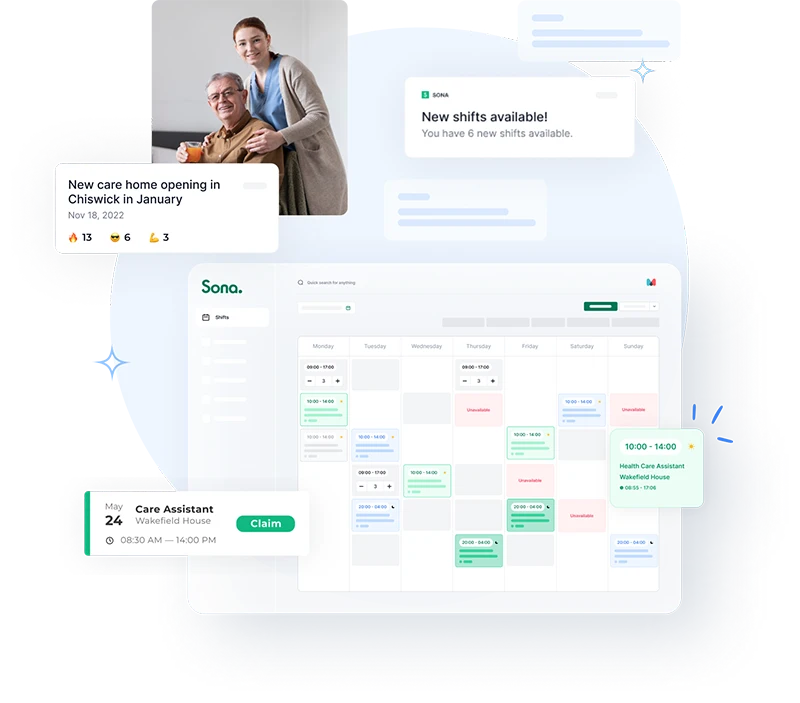
Give staff greater visibility of shifts available to work, with a simple "shift claim" process to increase their income.
Improve employee engagement and retention with a seamless employee communication platform.
Happier staff provide greater customer experiences, which in turn drives return rates, revenues and recommendations.
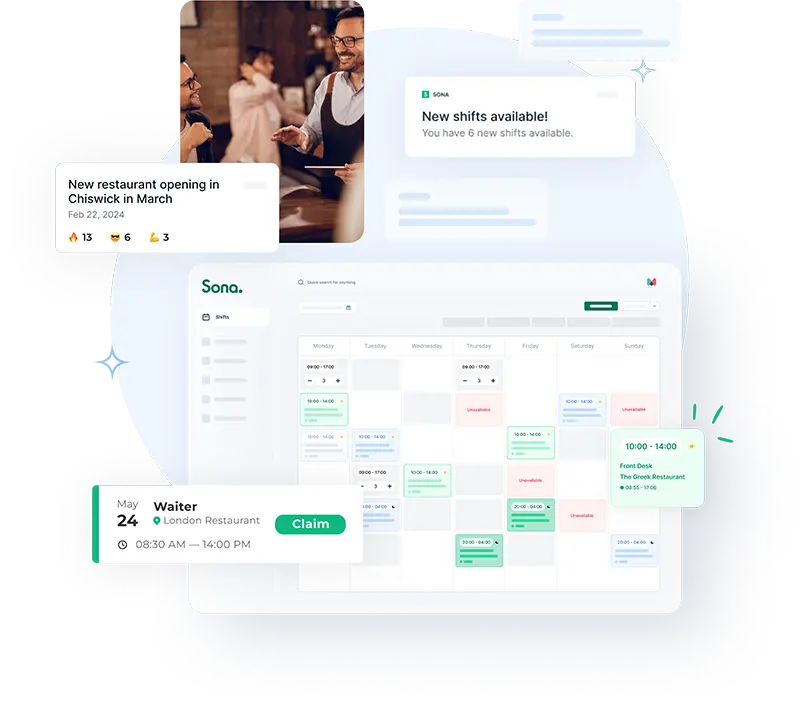
Give staff greater visibility of shifts available to work, with a simple "shift claim" process to increase their income.
Improve employee engagement and retention with a seamless employee communication platform.
Happier staff provide greater customer experiences, which in turn drives return rates, revenues and recommendations.
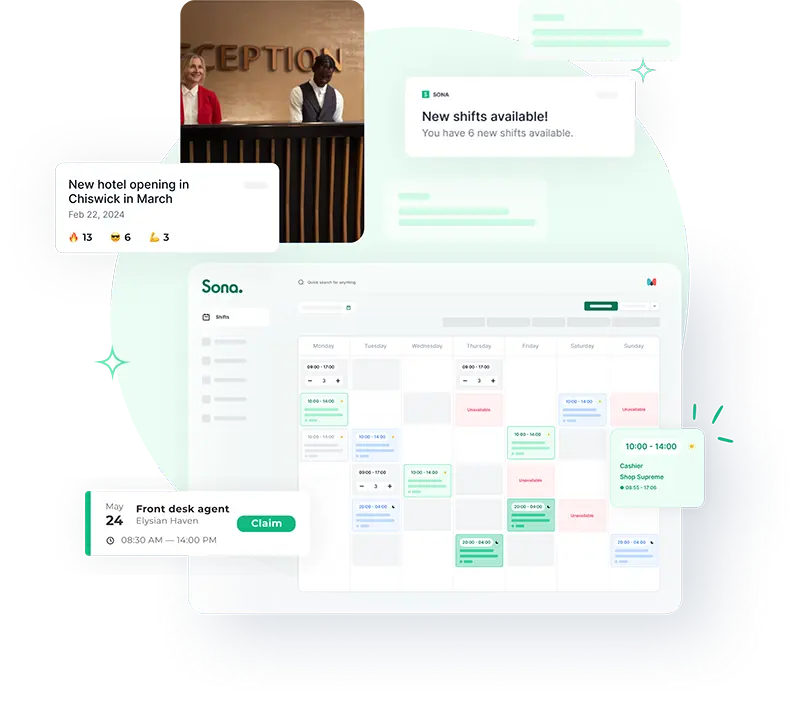
Meet the Sona team online with our webinar series or in-person at an event near you.
New research, insights, and strategies for frontline leaders.
Downloadable templates, reports and guides from Sona.
Stay up to date with the latest Sona news and research.
Learn how our customers are transforming their people operations.
| 3 min read
Sona and Borderless announce an exciting partnership.
| 2 min read
Sona and Found by Lottie announce an exciting partnership.
| 4 min read
Remove operational errors, drive efficiency, and help your team spend less time on admin with a unified solution.
PUBLISHED: February 2025
Download the report to learn how hospitality operators are embracing AI challenges and opportunities in 2025.
PUBLISHED: January 2025
Reveal the most important metrics in 2025!
PUBLISHED: December 2024
This infosheet is packed with practical insights to drive high-quality, low-regret WFM purchases.At Sona, we are passionate about building technology that makes a genuine difference to the lives of Social Care staff.
Sona is the award-winning next generation workforce management platform that combines the functionality you expect from any management solution - including Scheduling, Engagement, HR and Payroll.
With dedicated features to empower staff and solve the unique challenges of Social Care, we are the leading user-friendly, end-to-end platform that prioritises both efficiency and wellbeing.
Book a demoAt Sona, our approach to Social Care goes far beyond just understanding – we specialise in it.
Similarly, our commitment to innovation is reflected in strategic partnerships and integrations to ensure your tech stack is not just current, but future-proof.
To see how Sona's core features distinctly outperform our competitors', we invite you to explore the detailed comparisons in the table below.
3rd generation of WFM |
Large legacy providers | Industry agnostic providers | ||||
|---|---|---|---|---|---|---|
| Industry knowledge | More than 90% of Sona customers are Social Care organisations. Our clouds, features and integrations all have a specific Social Care focus. Richard, our Head of Product, had over 10 years of experience working in Social Care before joining Sona. We know that Social Care organisations vary amongst each other, too, so we have made Sona highly configurable. |
While the appeal of legacy systems may be understandable due to their perceived market presence, these often fall short in addressing the unique challenges Social Care is experiencing now. For instance, there is no way of tracking safe staffing levels, viewing your schedule by People You Support or even seeing the type of care being delivered on each shift. While it’s likely legacy providers may have some industry experience, they will not have the degree of focus Sona channels into building our product. |
Industry agnostic providers generally offer the same features to every customer, regardless of their industry. However, Social Care organisations often have specific operational activities and require a degree of complexity that not many other sectors do. Therefore, industry agnostic providers may not have the knowledge and product quality necessary to satisfy a Care organisation that aims to thrive. |
|||
| A singular, dynamic ecosystem | Sona has built a full end-to-end solution for Social Care enterprises with HR, Scheduling and Payroll working together. Leading Social Care organisations such as Advinia Healthcare, Caring Homes & Innovate Trust have already switched their older systems to Sona. |
Although advertised as an "all-in-one solutions", legacy providers more often than not grew through acquisitions. This means their products often don't have a smooth, native integration; rather they are two separate solutions which might require additional development to communicate effectively. |
Industry agnostic providers are unlikely to offer the range of systems needed in Social Care, meaning an end-to-end solution can be difficult to achieve without integrating with an additional external vendor. |
|||
| Key partnerships | Integrations are key in order to build a future-proof tech stack, as no product will ever do absolutely everything to a high-enough standard. Sona has a strong partnership with Camascope for medication management, and is close to completion of a deep integration with Nourish for care planning. We additionally have existing integrations with a variety of other Social Care specific vendors and are always open to learning about new potential partnerships if you would like to keep any of your older systems. |
Large legacy providers typically offer end-to-end solutions but tend to be inflexible in integrating with other systems. This rigidity can be a disadvantage, as they often lack collaborative relationships with other key vendors you may wish to keep. |
Industry agnostic providers are often not willing or equipped to integrate with Social Care specific systems, which is a huge risk for any provider. | |||
| Ability to deal with large organisation complexity | Sona is specifically engineered to handle the complex needs of diverse service types and multiple locations, making it ideal for large and complex organisations, including those with multiple types of shifts, pay rates, and internal rules. With tailored support and dedicated implementation managers for enterprise organisations, Sona stands out in its ability to adapt to and manage these intricacies efficiently. Designed to be highly configurable for each customer, our focus is currently on supporting organisations of 250+ employees. |
Large legacy providers often demonstrate a notable rigidity in their approach, showing resistance to modify or adapt their systems to better suit the complex requirements of enterprise organisations with various service types and locations. This inflexibility becomes evident, especially when dealing with organisations that have various types of shifts, pay rates, and organisational rules. Consequently, customers struggle with fitting the existing system into their intricate internal structures. This often leads to significant inefficiencies, increased room for error, and more manual workarounds for teams. |
These providers primarily cater to small and medium-sized businesses (SMBs), with a focus on self-signup customers. Their support infrastructure and services are specifically tailored to meet the needs of this segment. As a result, they have faced challenges in accommodating large-scale enterprise customers, particularly in managing substantial user numbers from a single client as well as the complexities of their organisational rules. |
|||
| A modern, user-friendly system | Sona is the next generation of workforce management, solving complex care challenges with easy-to-use technology that drives high engagement with both managers and employees. Our design teams are dedicated to continuous improvement, regularly conducting research and testing with Social Care staff to fine-tune both the Sona mobile app and the desktop experience. We strive to make our tools not just intuitive, but also supported by helpful clickable demos, FAQs, and user guides. |
Systems from legacy providers often lack the modernity and user-friendliness seen in solutions from newer providers. This can lead to employee frustration, as even simple tasks become tricky to perform. Also, many providers fall short in offering dedicated mobile apps for iPhone and Android, further limiting ease of use and accessibility. |
Newer providers often present systems that are modern and intuitive, yet these are tailored for a broad range of industries. This generalised approach leads to challenges in Social Care settings, where specialised features are crucial. The absence of a focused design for Social Care means that industry agnostic systems won’t fully address your unique needs, leading to employee frustration and operational inefficiencies. |
|||
| Reporting and dashboards | At Sona, we know that operational efficiency depends on the quality of your data. That’s why every data dashboard in Sona is fully configurable, giving you instant access to the reports and insights you need across locations, roles and departments. What’s more is that your login view can be fully customised to show the dashboards most relevant to you, without ever having to jump between multiple screens or accounts. |
Legacy providers have certain limitations in data consolidation and accessibility. Users managing multiple regions or service types often find themselves navigating through multiple databases to obtain specific location-based information. For instance, regional directors overseeing various locations face the challenge of logging into separate accounts to analyse critical metrics, unable to view this data collectively in one place. This lack of unified data presentation can seriously hinder efficiency within teams. |
These providers usually offer only basic reporting, with no new report types added recently, as it's not seen as a priority because of the sheer diversity of industries they serve. Unlike Sona's customisable dashboards, they might not even provide any dashboard functionality, limiting users in data visualisation and quick access to key insights. |
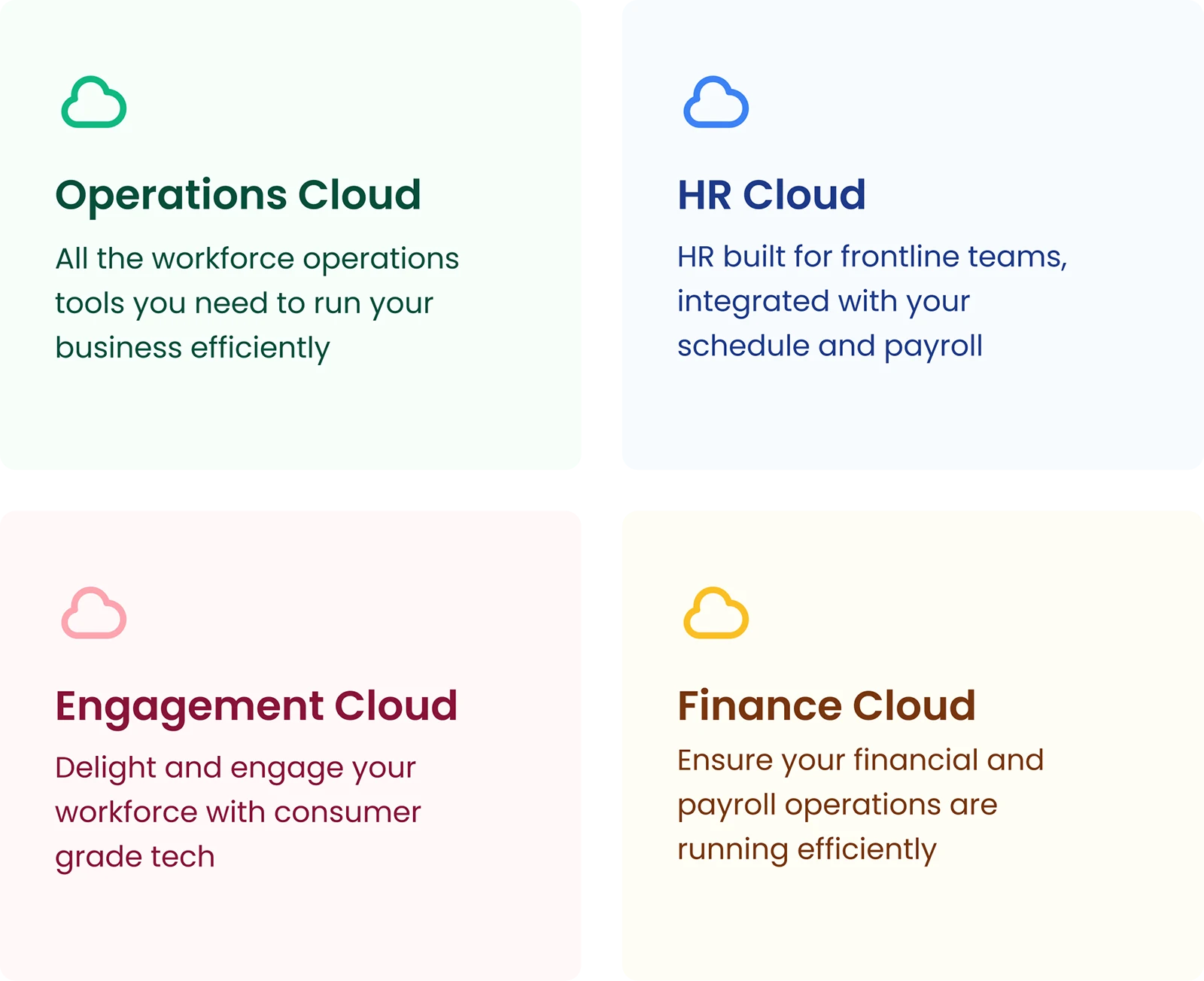

Sona stands out against other providers with a comprehensive, cloud-based suite tailored to meet the specific needs of the Social Care sector.
Each of our four key clouds is designed to streamline and enhance every aspect of your organisation. Dive into the comparison below to discover how each of Sona's clouds delivers superior functionality, setting a new standard in the industry.

3rd generation of WFM |
Large legacy provider | |||
|---|---|---|---|---|
| A vital link between HR & Scheduling | There are certain elements of your tech stack that require infrequent integration (for example, ATS to HR) but there is one which must have a 100% seamless, near real–time integration, and that is between HR and Scheduling. This is vital for operational accuracy and efficiency. Built by the same team, Sona HR and Sona Scheduling are intrinsically linked, forming one part of the same end-to-end system. This ensures not only a seamless connection but also minimises errors, particularly in payroll, and optimises compliance and resource allocation. The cohesive development of both functions within Sona stands as a clear advantage, providing a smooth and reliable experience. |
Large legacy systems often display challenges in integrating HR and Scheduling effectively. While they may provide both functionalities under one name, the integration is typically less robust. This is often due to the combination of a system developed in-house with another that's been bought and rebranded, which can lead to a superficial connection between the two functions. Such an approach can result in increased inefficiencies, a higher risk of payroll errors, and potential compliance issues, making the integration less reliable and efficient compared to end-to-end solutions like Sona. |
||
| Scheduling that can handle Care specific nuances such as safe staffing levels | Sona's advanced scheduling was built specifically for Social Care, prioritising flexibility and configurability due to the complex nature of Care operations. Sona's scheduling system has multiple Care specific features that help organisations ensure safe staffing levels in their locations. These features include Care Requirements in the schedule, Skills Mix and Shift Filler. |
While legacy providers may have an advanced scheduling system with simple and usable features, there might not be any features designed specifically for Social Care. This will cause inefficiencies and make it challenging for organisations to have oversight into crucial areas such as safe staffing levels. |
||
| 'People We Support' schedule view | In Sona’s People We Support schedule view you can view the care type, the responsible staff member, and any shared support arrangements, shift-by-shift. | Many legacy providers are industry agnostic and therefore, lack any care specific features including schedule types. | ||
| Shift marketplace | Sona's innovative shift marketplace allows for the creation and sharing of open shifts, ensuring fair access to overtime opportunities. Shifts can be offered to employees at the selected location or those within a specified radius who meet the eligibility requirements. This process is designed for fairness and transparency, allowing for staged release of shifts and reducing reliance on agency workers. Prioritising internal staff in this manner fosters a more equitable and efficient work environment, while reducing the need for agency staff. |
Legacy providers' approach for requesting overtime usually has several limitations. Unallocated shifts are automatically visible, without control over which ones are offered for overtime. Managers receive no alerts for shift requests, resulting in frequent manual checks. Without time stamps on requests, determining the order of requests becomes impossible. Additionally, once a shift is allocated, employees aren't automatically notified, leading to a lack of awareness about updated rotas. The absence of alerts for unassigned overtime requests further complicates the process, leading to missed opportunities and errors. All of the above can severely impact organisations and their efficiency. |
||
| Shift Filler | As mentioned, Sona’s Shift Filler feature ensures that staff members are given priority access to available shifts, reducing the need to outsource to agency workers. Additionally, organisations can choose to have an escalation process of how they release their open shifts, showing to all full-time employees first, then to their bank teams, before assigning to an agency if no one has picked up the shift 24 hrs prior. |
Many legacy providers' approach to filling unallocated shifts is based on the assumption that if a manager doesn't assign it to an employee, then agency staff is required. This may inadvertently lead to increased agency spend as customers find themselves more dependent on external workers to fill shifts because they are not made easily available to staff. |
||
| Skills Mix | Sona allows users to select the required and preferred skills for any individual shift. Skills and qualifications are held against employee records, and so only employees with the required skills mix can see relevant open shifts. For example, if a shift requires the administration of specific medication, it will only be made available to employees that are qualified to administer it. This feature not only streamlines the scheduling process but helps ensure they are matching the correct employees to help achieve their residents' goals. |
Many legacy providers offer the option to add qualifications to employee profiles, but this feature is underutilised due to the maintenance it demands. Managers often find themselves unable to view specific skills they deem important for scheduling such as manual handling or medicine administration. |
||
| Contracted hours | Sona simplifies managing contracted hours with its intuitive schedule view. Each employee's contracted hours versus their scheduled hours for the selected week are clearly displayed, with colour coding indicating whether they are over or under their contracted hours. This feature enables managers to schedule shifts more effectively while ensuring compliance. |
While legacy providers have a function for this purpose, they often lack user-friendliness and clear presentation. This means it’s often not utilised by managers which can lead to challenges in effectively monitoring and adjusting staff schedules to align with contracted hours. | ||
| Employee wellbeing tools | Sona prioritises employee wellbeing. It offers a feature where employees can leave quick post-shift feedback, a vital tool for managers to monitor team morale. This functionality helps in identifying employees who might be at risk of leaving, allowing for timely interventions and support. Such tools are essential not only for understanding employee wellbeing but also for improving retention. By proactively addressing concerns and fostering a positive work environment, Sona aids in maintaining a satisfied and engaged workforce. |
Legacy providers don't often focus on employee wellbeing. This lack of essential tools needed for understanding employee morale can impact retention goals. Managers may struggle with gauging team satisfaction or identifying early signs of employee dissatisfaction, potentially leading to higher turnover rates. |
||
| Newsfeed | Sona's Newsfeed allows for the distribution of targeted announcements, whether they're intended for specific teams, locations, or the entire company. Tailoring announcements is essential for ensuring relevant information reaches the right employees, without overwhelming everyone with broad communications. |
While some legacy providers have a newsfeed, it often lacks the ability to send targeted announcements. All communications are broadcast to the entire organisation, which can lead to information overload and reduce the impact of specific, relevant updates. |

3rd generation of WFM |
Industry agnostic provider | |||
|---|---|---|---|---|
| Scheduling that can handle Care specific nuances such as safe staffing levels | Sona's advanced scheduling was built specifically for social care, prioritising flexibility and configurability due to the complex nature of care operations. Sona's scheduling system has multiple care specific features that help care organisations ensure safe staffing levels in their care homes. These features include care requirements in the schedule, skills mix and Shift Filler. |
While industry agnostic providers may have an advanced scheduling system with simple and usable features, oftentimes no features have been designed specifically for Social Care. This will cause inefficiencies and make it challenging for organisations to have oversight into crucial areas such as safe staffing levels because these concepts aren't common to other sectors, therefore providers aren't motivated to develop them. |
||
| 'People We Support' schedule view | In Sona’s People We Support schedule view you can view the care type, the responsible staff member, and any shared support arrangements, shift-by-shift. | This feature is specific to Social Care, therefore industry agnostic providers don't tend to have it, as it's not common enough to other sectors to justify the development process and costs. | ||
| Shift marketplace | Sona's innovative shift marketplace allows for the creation and sharing of open shifts, ensuring fair access to overtime opportunities. Shifts can be offered to employees at the location or those within a specified radius who meet the eligibility requirements. This process is designed for fairness and transparency, allowing for staged release of shifts and reducing reliance on agency workers. Prioritising internal staff in this manner fosters a more equitable and efficient work environment. |
Open shifts can be created and shared with employees who have the specific location assigned on their profile. There is often no process in industry agnostic solutions for making overtime available to interested skilled employees who work at other locations. |
||
| Assign to agency | Sona’s Assign to Agency allows agencies to be created for rota purposes only. If an open shift hasn’t been picked up by an employee 24 hrs prior, a manager can assign it to a preferred agency and agency worker from their supplier lists. These can be shown in reporting and incur no additional costs as they are not counted as physical users in the system. | Industry agnostic systems usually require creating multiple ‘dummy’ users per location for agency assignments which incurs additional costs. Managers can become frustrated at this process as two of the same users cannot work two shifts at the same time in one or more locations. Therefore, the need to create multiple dummy users per location exists, which further drives up costs. |
||
| Multiple roles / locations | Sona has strong role assignment capabilities for employees with multiple roles & multiple locations. For example, employees can be assigned an admin site along with sites where they can also appear on the schedule without impacting contracted hours, pay rates or leave entitlement. |
Depending on hierarchy, role assignment can sometimes be confusing with industry agnostic solutions. This gets more difficult when there is more than a single location attached to an employee. | ||
| Multiple leave entitlement for multiple contracts | Sona can apply multiple contracts assigned to separate locations, each with their own leave entitlement. Sona can also apply different weekly contracted hours per role. | With industry agnostic providers, leave entitlements are driven by the contract assigned to the employee’s "main location." The system usually only allows you to apply one set of contracted/agreed hours per employee which makes managing multiple contracts tricky. |
||
| Document management | Sona enables you to securely store important documents like contracts, visas, and certifications. To ensure timely reviews and renewals, you can set up alerts for upcoming document expirations, keeping everything organised and up-to-date. We offer the convenience of effective dating, allowing you to schedule future-dated changes for contracts or pay rates seamlessly. |
Industry agnostic systems often have current settings always in play, as they doesn't support effective dating. This means you're unable to schedule future changes for contracts or pay rates, which must be managed in real-time. This requires more manual updates for your teams to apply changes as they occur. |
||
| Offboarding | Offboard features are available in Sona, making the transition as smooth as possible for both the organisation and the departing employee. | With industry agnostic providers, offboarding is limited to simply deactivating the employee in their system, with no further support available, meaning managers have to complete more tasks when an employee leaves. | ||
| Employee wellbeing tools | Sona offers a feature where employees can leave post-shift feedback, a vital tool for managers to monitor team morale. This functionality helps in identifying employees who might be at risk of leaving, allowing for timely interventions and support. Such tools are essential not only for understanding employee wellbeing but also for improving retention. By proactively addressing concerns and fostering a positive work environment, Sona aids in maintaining a satisfied and engaged workforce. |
Industry agnostic providers often lack the essential tools needed for understanding employee wellbeing and improving retention. Managers may struggle with gauging team morale or identifying early signs of employee dissatisfaction, potentially leading to higher turnover rates. |
||
| In-app communication | Sona enhances internal communication with its 1-1 and group messaging features, all within the same secure app. This is essential for maintaining privacy and confidentiality, ensuring that sensitive employee and client information remains protected. This also improves employee engagement, allowing staff to easily connect with managers or colleagues without the need for external messaging platforms. |
Industry agnostic providers don't often offer this feature. Without an in-app messaging, organisations can experience limitations in their internal communication processes. Without this feature, your teams are made to rely on external messaging services, potentially compromising privacy and data security. This separation can also create challenges in quickly reaching out to managers or team members, potentially impacting coordination and efficiency. |
||
| Pay periods | Sona offers the flexibility to customise pay periods at the point of payroll processing, accommodating variations like 4 week or 5 week cycles. This adaptability is crucial for aligning with your diverse payroll needs and ensuring accurate and timely pay-outs for employees. | Industry agnostic providers usually requires setting pay periods within the employee's contract details, and lack the capability to manage 4-week or 5-week alterations. Users are generally restricted to standard weekly, biweekly, 4-weekly, or monthly schedules, potentially limiting flexibility in payroll management. |


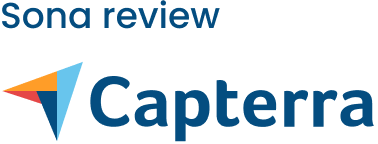


Claire Kennedy
Head of HR, Advinia Health Care

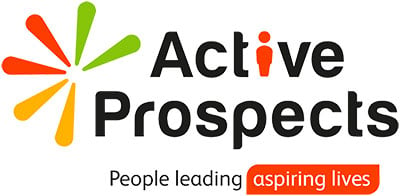
We'd love to learn more about your organisation and explore what Sona can do for you.
Let us know your number and we'll call you soon.
Arrange a Zoom call at a time to suit you.
Drop a line to our co-founder Oli - he'd love to hear from you.